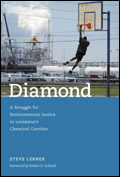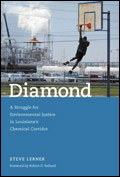When Margie Eugene-Richard won the Goldman Prize last year, it was a stunning public recognition of decades of struggle. Richard — the first African-American to win the award, which some refer to as environmentalism’s Nobel Prize — had waged a 30-year campaign against Shell Chemicals with fellow residents of Diamond, La. Like the proverbial David, the African-American, working-class neighborhood took on a Goliath — and won.

Diamond
by Steve Lerner,
MIT Press,
344 pgs., 2005.
But the fight against Shell was not just the singular achievement of an individual activist, as Richard would be the first to admit. It was a collective one, and Steve Lerner’s readable and engaging Diamond: A Struggle for Environmental Justice in Louisiana’s Chemical Corridor ably tells the rest of the story.
Lerner was introduced to the people of Diamond by his brother, with whom he works at Commonweal, a health and environmental research institute in California. The more he learned, the more he realized the events in this small community reflected the struggles of the broader U.S. environmental-justice movement.
That movement’s aims include highlighting the disproportionate pollution people of color face, and the unequal protection offered them by government agencies. This battle is particularly potent in the area along the Mississippi River where Diamond sits — a stretch dubbed “Cancer Alley.” (For an excellent overview of the region, read J. Timmon Roberts and Melissa Toffolon-Weiss’ Chronicles from the Environmental Justice Frontline.) And though Diamond’s story ended in triumph — in 2002, Shell agreed to invest $200 million to reduce emissions at its plant, contribute $5 million to a community development fund, and finance relocation for residents — it reflects the challenges countless communities face, along the Mississippi and around the country.
With clear prose, Lerner provides an exhaustive minute-by-minute look at the campaign while contextualizing it in a historical framework. By detailing the roles of race and history, the key work of local and national environmental and legal advocates, and the politics of the negotiations between Shell and the local community, he reveals the complicated story behind a rare victory against a major corporate polluter — and offers a glimpse of a future where more victories are possible.
In the Rough
He begins it all with the simple observation that Diamond, sitting between the fence line of a Shell Chemicals plant and a Shell/Motiva oil refinery, “is not a place where most people would choose to live.” Its residents breathe toxic fumes, suffer high rates of cancer and other serious illnesses, and are subject to periodic deadly explosions. They report that on “bad days” the air makes their eyes sting, plays havoc with their sinuses, and causes coughs and headaches. And there is no escape: “There is always this faulty air,” one resident told Lerner. “You can smell the odor in your house.”

What’s in the air?
Photo: Thom Scott.
According to one analysis, in 1997, the Shell/Motiva complex released 2 million pounds of toxic chemicals. The Shell Chemicals plant, for its part, produced epichlorohydrin, methyl ethyl ketone, allyl chloride, specialty resins, hydrochloric acid, and secondary butyl alcohol. Wilma Subra, a chemist who consulted with the Diamond community, said these chemicals were known to cause a variety of problems, ranging from skin allergies to lung cancer.
So why stay? The answer lies in a combination of roots, community, and money. Lerner traces the town’s past to the Trepagnier Plantation, where many of the current residents’ ancestors were slaves. The plantation, the epicenter of a failed rebellion, grew into a neighborhood. Shell arrived in 1929; when the company began expanding its plant in 1953, it forced black residents off their land, offering meager compensation. Its messy approach continued in later years, as it paid low damages to survivors after deadly explosions in 1973 and 1988. Lerner shows how the “raw wounds” of this history, combined with a more recent pattern of residential and occupational segregation, helped shape residents’ attitudes.
Shell — which, with operations in more than 140 countries and territories, is one of the world’s largest multinational corporations — is given a voice in the book as well. Lerner touches upon individuals within the company who influenced the campaign, including Barry McCormick, an environmental engineer turned whistleblower. Then there’s spokesperson David Brignac, who surmounts his role of corporate image polisher to speak with conviction about the effects that years of protests and negotiations had — on both sides.
Diamond also touches upon the complicated question of how the perceptions of local white residents framed their opinion of Shell as a “good neighbor.” (Fenceline: A Company Town Divided, an excellent documentary shown nationally in 2002, also highlighted this racial divide.) The white residents, many of whom worked for Shell, actively denied that there were any negative health effects from the facilities. Their position is a key part of the story, and a key to understanding the relationship between environmental activism, race, labor, and class politics.
In the last section, probably of greatest interest to grassroots activists, Lerner describes the convergence of allies who came to lend support to the campaign, profiling individuals and groups, including the Deep South Center for Environmental Justice, Earthjustice, Greenpeace, the Natural Resources Defense Council, the Louisiana Environmental Action Network, and CorpWatch, which helped make connections between this local struggle and global organizing against Shell.
He also discusses a citizen-scientist air-sampling program called the Louisiana Bucket Brigade, which helped Diamond make its case. This focus on community-based research reveals an important facet of the evolution of the U.S.-based environmental-justice movement. As documented in two recent books — Barbara Allen’s Uneasy Alchemy: Citizens and Experts in Louisiana’s Chemical Corridor Disputes and Jason Corburn’s Street Science: Community Knowledge and Environmental Health Justice — communities are moving beyond individual protests to really change the agenda of research and regulation. The recognition that existing regulatory structures don’t consider the cumulative effects of pollutants on individuals and communities is being increasingly addressed through science and policy at the state level: the California EPA, for example, recently developed an environmental-justice action plan that uses cumulative impacts and the precautionary approach as guiding principles.
In the end, no person, organization, or event is left out of this book — which is both its central strength as a narrative and central flaw as an analytic study. Because it focuses on so many aspects of this complex and, in many ways, unique campaign, it’s difficult to draw themes or lessons that could be applied in other cases. Although Lerner offers a solutions-focused “Lessons Learned” chapter, it seems short and underdeveloped.
But the vital point is not diminished: substantial policy changes are coming about, in large part because of the activism of communities like Diamond. As Lerner documents, history, science, and environmental policy all matter when it comes to understanding why certain communities are subject to “toxic assault” — and why, faced with activism by the right allies, even a giant will budge.



